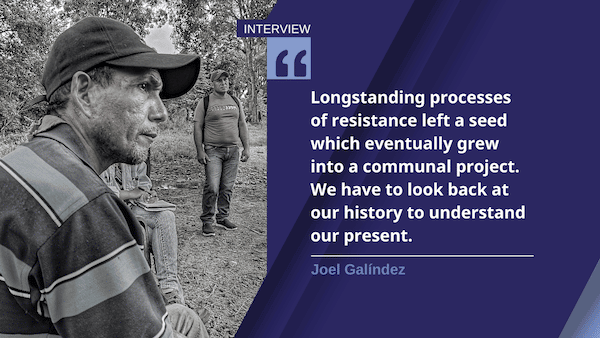In the south of Yaracuy state, Urachiche is a township nestled between the Aroa mountains and the flatlands that open onto the Venezuelan llanos. It has a long history of struggle and—together with the neighboring Bruzual township—forms the heart of the vibrant cult of María Lionza, a syncretic goddess that brings together Indigenous and African traditions.
Urachiche is also home to two closely-related communes: Hugo Chávez and Alí Primera. Here we learn about the history of these communes and their struggles to collectively control the land.
[This piece, part of the Communal Resistance Series, will be followed by articles delving into the two communes’ organization and production. Future pieces will also examine the challenges that communards face when building an alternative society in a country under blockade.]
The historical current
Coined by the Venezuelan left, the term “historical current” [corriente histórica] refers to the continuity of past and present struggles. The Urachiche township, home to one of the most intense and long-lasting histories of struggle for land and collective justice, is a case study in this dynamic. Here, the Alí Primera and Hugo Chávez communards tell the story of their struggle for land and its deep historical roots.
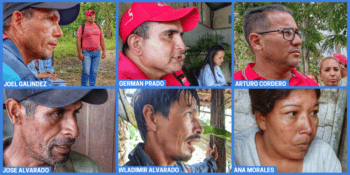
Joel Galíndez is a coop member at the Fundo San Simón and a parlamentarian for socio-productive organizations at the Hugo Chávez Commune | Germán Prado is a spokesperson for the Hugo Chávez Commune | Arturo Cordero is a communard, founder of the communes, and Urachiche Councilmember | José Alvarado is a member of the Alí Primera Commune | Wladimir Alvarado is an Alí Primera Commune parlamentarian and a coffee producer | Ana Morales is an Alí Primera Commune parlamentarian and a member of the communal bank. (Voces Urgentes)
RESISTANCE TO SPANISH COLONIZATION AND THE “CUMBE”
Joel Galíndez: What we see now taking shape here in Urachiche is part of the historical current. Longstanding processes of resistance left a seed which eventually grew into a communal project. We have to look back at our history to understand our present.
Our struggle began when the Indigenous peoples resisted colonization, which was followed by the creation of the cumbe. Cumbes were egalitarian communities where people who had escaped slavery joined forces with the Indigenous peoples to live freely on the margins of the Spanish empire.
These lands also saw the campesinos joining forces with José Antonio Páez in the independence struggle. It was the pardos [can be translated as Brown people] who fought the Independence wars, and they can claim Venezuelan independence as their own victory as much as Bolívar’s. That victory laid the grounds for a bountiful future, but the oligarchy went back to its old ways.
The Independence War [1810-23] and the ensuing treason to the emancipatory project was followed by the Federal War [mid-19th Century], when the pueblo made Ezequiel Zamora’s slogan “Liberated Land and Free Men” [tierra y hombres libres] their own. Some 300 years of struggle and war culminated in Zamora’s death and oligarchical interests seemed to settle in for good… But did they? In fact, people continued to struggle here, in the south of Yaracuy. Later, in the 1960s, the guerrilla made these mountains their home base.
Douglas Bravo [main commander of the Venezuelan guerrilla] was here and Commander Magoya led a front based in these mountains. They left their teachings behind with us. And so, while the 1970s saw the military defeat of the National Liberation Armed Forces [FALN for its Spanish initials], the legacy of those brave men and women is still here with us.
We are the heirs of the historical current, and the communes here are their legacy as much as they are our doing. It is sad that some question our rebellious past and look favorably toward a mercantilized future, but the historical current is in our bloodstream and the future, for us, goes hand in hand with our past.
Germán Prado: The colonialist treaties tell us that the Jirajara, the Indigenous people living here, were exterminated by the Spanish troops in three years. This story is just that: a story! In fact, the Jirajara resisted together with people who fled slavery, and after a protracted war, the Spanish had to capitulate. That’s the story of the first cumbe [maroon community].
Arturo Cordero: The Indigenous peoples who inhabited these territories before the colonization were the Jirajara, but also the Guachire, Chirimagüe, and Urachiche tribes. They were Caribs, and the property of the land was communal.
The colonization of these territories happened around 1539, when it had been given over to the Welsers [German bankers to whom the Spanish crown gave control of what we now know as Venezuela between 1528 and 1546]. However, in 1552, there was an uprising in Buría [Yaracuy], a mountainous region. That was the first uprising against the Spanish colonists, and it lasted 75 years.
Around that time the Jirajaras and enslaved people who had run away began forming cumbes in these lands. After the long war, the Spanish Crown recognized the “Republic of the Nirgua Zambos” or what has come to be known as a “resguardo” [reserve].
The territory that was declared a “republic” was four times as large as any other reserve. What does this tell us? Yaracuy has been a holdout of resistance against imperialism and a reserve of communal organization. Long before the Paris Commune, we had cumbes that were democratically organized with common land.
Germán Prado: We are the heirs of the Indigenous peoples who resisted the violence of the colonialists, and there are elements in our communes with roots in their cosmovision. I will highlight one that is important for us: at the Hugo Chávez and Alí Primera communes there isn’t a bigshot or bigwig who runs the show, as happens in other organizations. Here, not only do we adhere to the formal precepts established by the Law of Communes, which are assembly-based, but our organizational DNA mingles with the egalitarian organization of the Jirajaras.
Arturo Cordero: Also, as opposed to the Indigenous peoples in the north of Yaracuy, those in the south were matriarchal. You can see that in the patron saints here, who are always female and often interlinked with pre-colonial mythologies, while in the north the patron saints are male. But the matriarchal legacy goes beyond these altars: the communal lifestyle is also linked to these old-yet-new forms of organization.
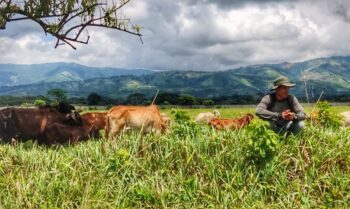
Hugo Chávez Commune, a landscape. (Voces Urgentes)
INDEPENDENCE, THE FEDERAL WAR, AND TREASON
Arturo Cordero: Bolívar’s 1817 Ley de Haberes Militares [Law of Military Possessions] constituted a radical land reform. It turned the land taken from the Crown and colonists over to patriot soldiers and officers. However, ensuing years saw a class recomposition and the reform was reverted: many soldiers had no means to produce on their land, so the powerful men in the newborn republic took control of most land by different means.
This happened all around the country. Additionally, in 1846, before the Federal War, Fernando Espinal, an Urachiche judge, ruled in favor of the most powerful, dispossessing Indigenous people of their land. That is how they became serfs [“tributarios”] in their own territory.
This was followed by the Federal War [led by General Zamora], which bequeathed the “Liberated Land and Free Men” battle cry to us. Some 150 years later, this revolutionary slogan defined much of what the Bolivarian Revolution would try to do in the campo.
Along with many others, Prudencio Vásquez and José Blandfort—both from Urachiche—fought with Zamora in the early days of the war. In fact, it is documented that in a conversation between Zamora and Blandfort, the latter brought up Proudhon’s thesis that “Property is theft.” To that Zamora replied: “Property is theft when it’s not the product of work.”
The popular struggles for land and dignity provoked the wrath of the oligarchy. Zamora’s troops were defeated, but the embers of the revolution were constantly rekindled as the people continued their fight.
One hundred years later the pueblo picked up arms against the oppressor yet again.
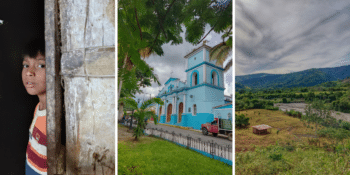
Left to right: A kid from Maimire, Alí Primera Commune; Urachiche Church; Alí Primera Commune. (Voces Urgentes)
THE GUERRILLA
José Alvarado: I am a communist and a guerrillero. I was raised in Cerro Atravesado, in the mountains between Lara and Yaracuy, in a poor campesino family.
It all began when I was a child. Whereas the army harassed and dispossessed the working people of the campo, the guerrilla was respectful and solidarious with the campesinos. When they needed something, they would purchase it from us.
That is why I joined the guerrilla, where I learned how to read and I became a political-military cadre.
Arturo Cordero: As soon as the FALN took up arms, Urachiche became an epicenter of the guerrilla struggle. A group of armed men that took the name of Livia Gouverneur—a young communist student who had been killed one year before—entered into the territory and began to forge links with the campesinos, who had a great deal of sympathy with the cause. The Livia Gouverneur comrades were part of the larger José Leonardo Chirinos Front.
That resistance struggle was joined by many of the locals and the mountains of Urachiche became known around the country as an important guerrillero holdout. In fact, it became an epicenter of sorts for guerrillero fronts. In the most rough mountain range that stands behind us, in Cerro Atravesado, there is a place called the Red Square, and that is where the guerrillero fronts would meet.
People like Calistro Efraín Rojas, one of the first combatants, come from here, as did his son, our beloved teacher Felipe Rojas. Magoya, the guerrillero commander, made this land his home base with his wife, Commander Milagros, who was actually from Urachiche.
Ana Morales: The persecution of the guerrilleros was brutal: if the army caught them, they would be either tortured or killed. In these mountains, the sympathy with the guerrilleros was broad. After all, the people here were victims of the state’s repression and despotism as well. They shared the guerrilla’s vision for a more just world. They [the guerrilleros] were also teachers: many people learned to read with them.
Wladimir Alvarado: Some say that the guerrilla was defeated, but the story is not so simple. The truth is that they left many teachings behind. That is why I say that the Bolivarian Revolution is the legacy of past struggles and that communism is a project that the guerrilleros bequeathed to us. We owe the struggle for the land to Zamora, and we owe socialism to the guerrilla. In fact, Chávez would often highlight the importance of the 60s insurgency when reflecting on our past.
Ana Morales: The guerrilleros rekindled old struggles and left us with many teachings. In fact, Felipe Rojas was our teacher. He would often explain to us that true socialism is about equality and solidarity, about living with dignity and rebuilding communities. That is what our communes are all about.
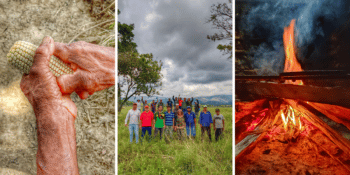
Left to right: Corn, Hugo Chávez communards, cooking fire in Maimire. (Voces Urgentes)
* * *
José Alvarado: Our struggle comes from way back. We were at it—fighting against the oppressive oligarchy—long before the Independence War. As communists, we suffered persecution, but the most important thing is that those struggles left behind an organized community.
That’s why, when Chávez arrived, we were ready. We had gone through years of political, ideological, and military preparation. We were as subversive as Chávez himself! We never expected that we would have a revolution via the vote, because our key role models were Che and Fidel. However, when we saw the man, we saw the potential to carry out a revolution, and the people of Urachiche committed themselves to a project that would first call itself Bolivarian and later socialist.
There is still much to do. There are many contradictions and not everyone is committed to socialism, but make no mistake: Here, in these mountains, the communes and the dream of a communist society are alive and well! In the lower lands, particularly in the big cities, some have given up, but up here the project is alive and well.
Germán Prado: Ours is a campesino organization and, for centuries, we have been struggling so that the land would go back to those who work it. Of course, when Chávez came to power, the correlation of forces changed, but the struggle goes on. That is why—with the Indigenous peoples who resisted the Spanish empire, with the campesinos who fought with Zamora, and with the guerrilleros who left their footprints in our mountains—we continue to struggle with the oppressed.
Arturo Cordero: Urachiche has a long history of struggle, with the fight to have land and justice at its core. That’s why, when Chávez defined the commune as the historical path towards socialism, the whole thing made sense to us, and that’s why Urachiche has three combative communes: Camunare Rojo (somewhat less active now), Alí Primera, and Hugo Chávez.
The communes of Urachiche are united in the struggle: we all have a debt to our ancestors. We, the dwellers and campesinos, are the great-grandchildren of the Indigenous and Black people who resisted the colonization; we are the students of Argimiro Gabaldón [a guerrilla commander who died in 1964] and the guerrilleros; and we are the sons and daughters of the coffee producers who, beginning in 1961, were able to displace the dreadful Giménez clan. The Giménez were a family that had stripped the campesinos of their crops for many years. Today the Urachiche campesinos own the land where they produce and the communes are the focus of political life in Urachiche.

